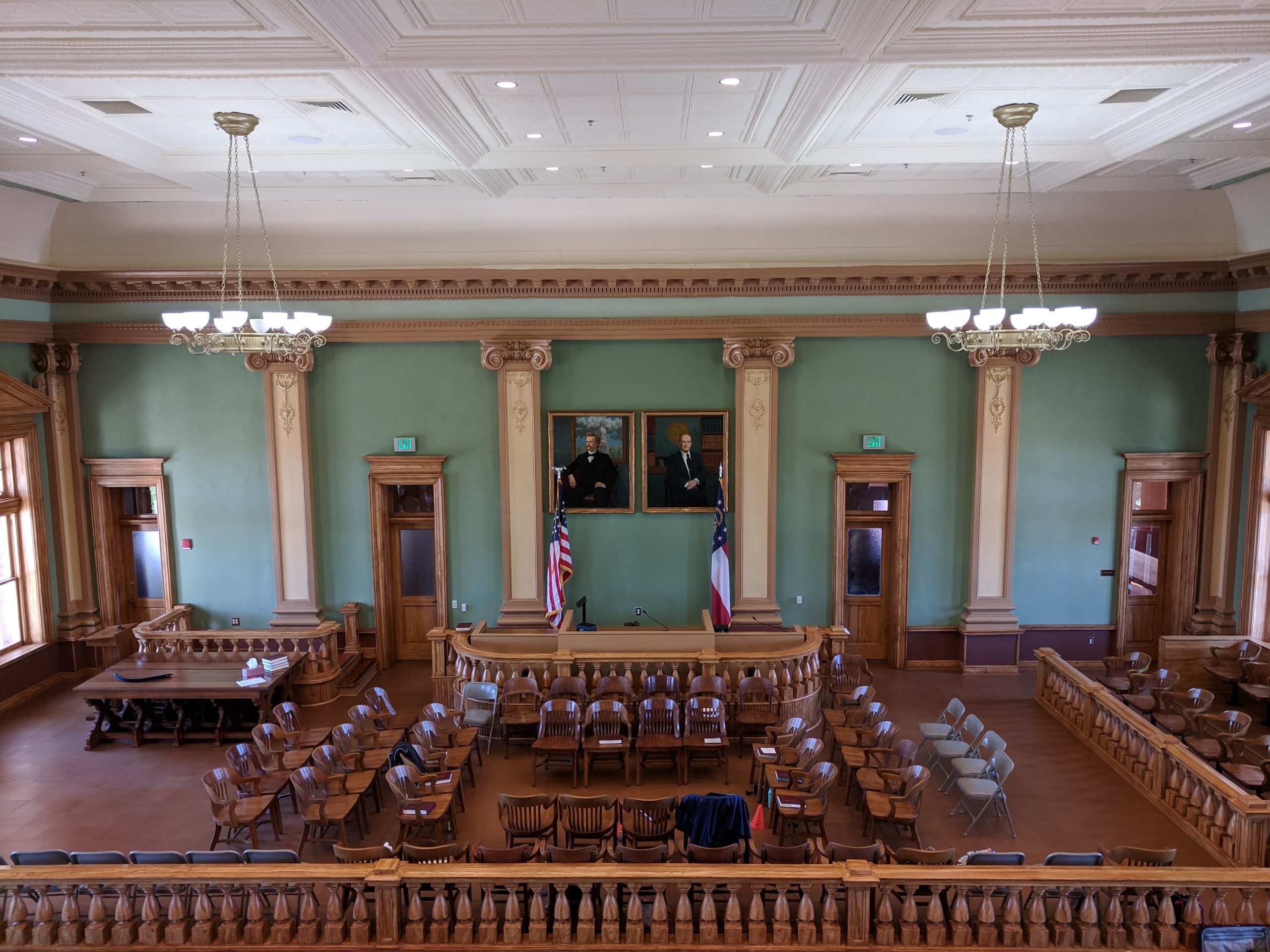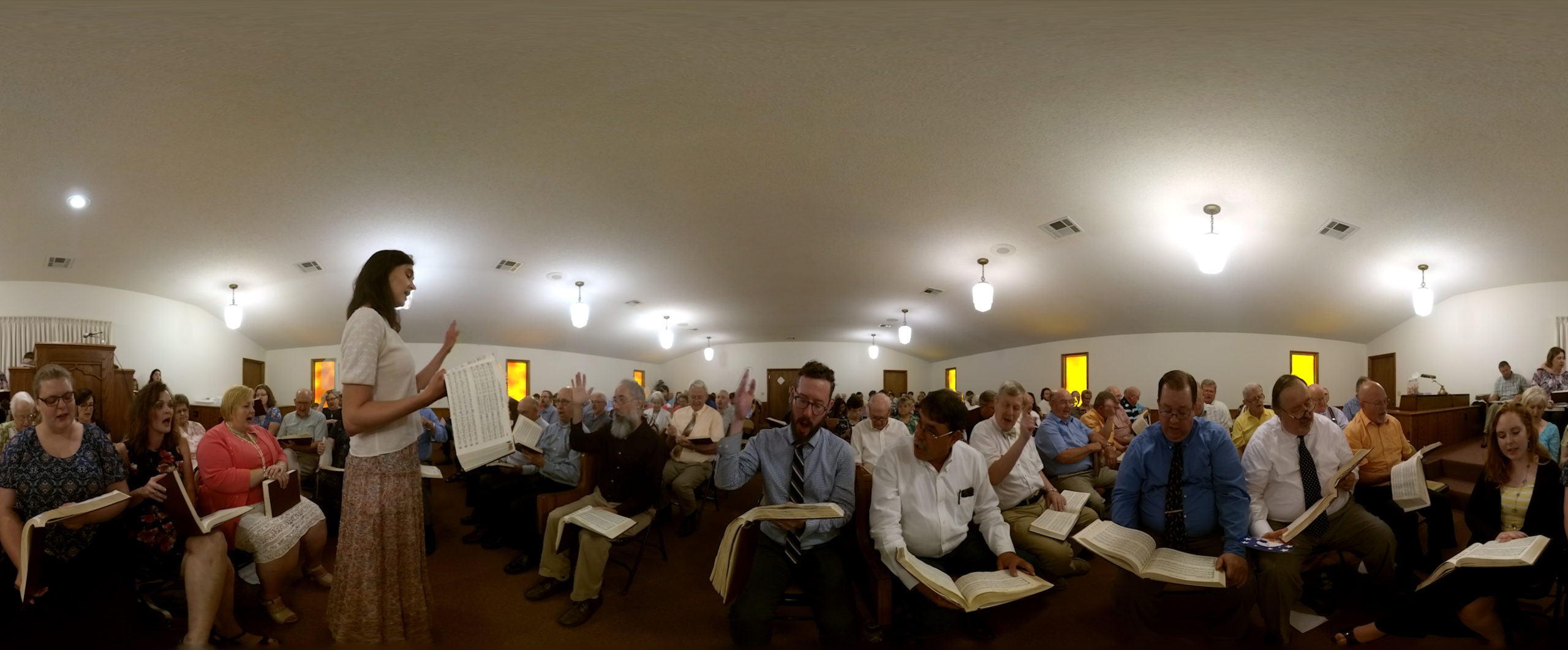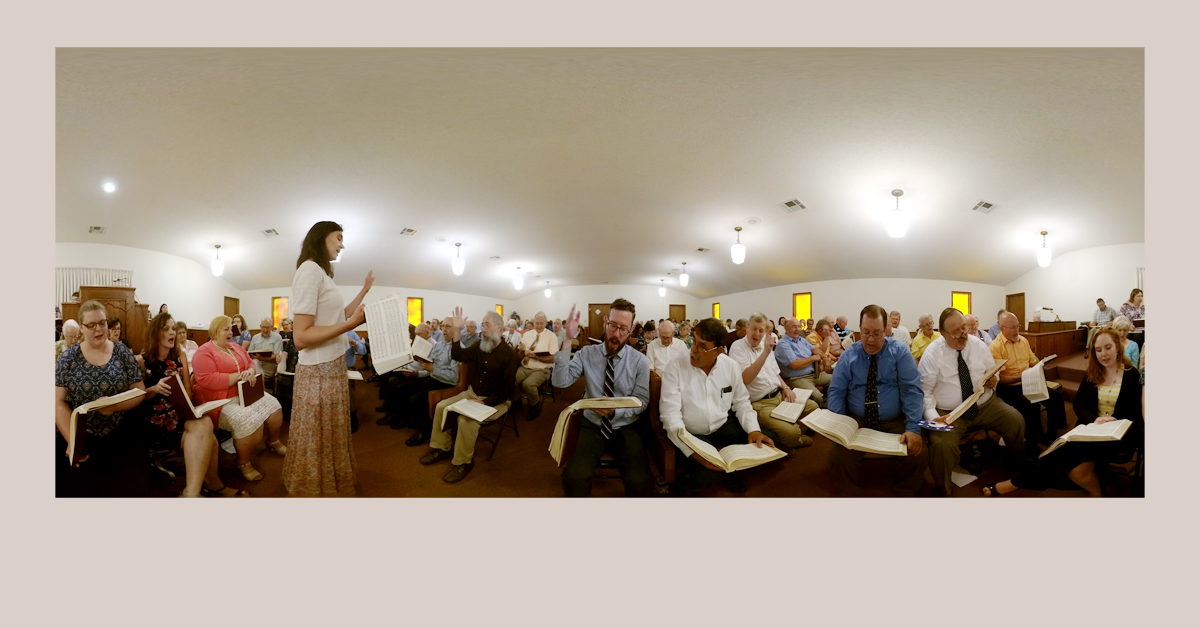For the first two months of 2020, well-attended Sacred Harp singings took place across the United States and in the two dozen countries where this music culture—rooted in Alabama, Georgia, Mississippi, Florida, and Texas—has spread over the past half century. When Steve Bransford and I published the first 360-degree audiovisual recordings of Sacred Harp singing in Southern Spaces in January, I couldn’t foresee that the spatial experience these recordings document would soon be a memory for the duration of the coronavirus pandemic. By late March, essentially all singings were cancelled.

For all those who are missing the experience of standing in the “hollow square,” the “spatial, aesthetic, and spiritual center” of this music culture, we are publishing five additional immersive videos from this vantage point recorded at last June’s Mt. Lebanon Baptist Church singing in Fayette County, Alabama. We hope the chance to be virtually immersed in this space many of us miss so much is a comfort in these strange times.
[360-degree videos can only be viewed on a desktop computer or in the YouTube app on a mobile device. Click and drag within the window or angle mobile device screen for 360-degree viewing. Use headphones for spatial audio.] Ewa Lichnerowicz, of Dublin, Ireland, leads S. M. Denson’s “Praise God” (p. 328) from The Sacred Harp. 360-degree video by Steve Bransford and Jesse P. Karlsberg. Read more at Southern Spaces.
As Steve and I noted in Southern Spaces, “there is no substitute for experiencing a Sacred Harp singing in person.” And during this time of social distancing, it’s hard to imagine an activity more prone to transmission of the coronavirus. Research shows that choral singing is among the activities with the greatest potential to spread the virus. One report highlights a chorus rehearsal at which a single infected participant spread Covid-19 to 87 percent of participants. Sacred Harp singing is even more physically intimate than most singing settings. Singers face each other around the hollow square we love so much. We sing at high volume in close quarters. Nearly every singer leads a song in the middle of the group, surrounded by voices and singing in the direction of other participants. Our collective sound courses through the air and each others’ bodies.

For Sacred Harpers, it’s terrible not to be able to sing with each other, a deeply meaningful practice for many. It’s worse still to be without the catharsis and closure that comes from singing for departed singers at the “memorial lessons” held at most singings, and at funerals. In the absence of presence, singers have sought elements of the aesthetic, social, and sacred experience of Sacred Harp singing from a range of digitally mediated replacements. Hundreds of singers recorded themselves singing songs solo, creating videos stitched together into a Sacred Harp “Quarantine Chorus” posted to YouTube. Although the short time delay that makes us speak over each other in videoconferencing apps renders them particularly unsuitable for singing together, Sacred Harp singers have found solutions of a sort. Some meet via Zoom or Houseparty to mute themselves and sing along with recordings or a pair of cohabitating singers. Others create chains of Facebook Live videos where each singer contributes their own voice part over the previous singer’s live video, playing in the background.
[360-degree videos can only be viewed on a desktop computer or in the YouTube app on a mobile device. Click and drag within the window or angle mobile device screen for 360-degree viewing. Use headphones for spatial audio.] Beth Wallace, Eady Porter, Aubrey Zeanah, and Ridley Colvin, of Fayette, Northport and Demopolis, Alabama, lead O. A. Parris’s “My Brightest Days” (p. 546) from The Sacred Harp. 360-degree video by Steve Bransford and Jesse P. Karlsberg. Read more at Southern Spaces.
All these substitutes offer some form of succor. It feels good to hear your voice mix with other voices. It feels good to see others while singing. It feels good, startling, and surprisingly moving to see so many people digitally juxtaposed in a floating hollow square, and to hear so many voices stitched together.
Yet these mediated representations also painfully illustrate just how much we’re missing. Our singing partners sound canned and tinny, distorted by laptop speakers, poor connections, and compression algorithms. Zoom’s rectangles are so redolent of remote work. On YouTube, the singers of the Quarantine Chorus, a hollow square comprised of floating heads and torsos atop a black background, are disembodied and out-of-space. Their voices are not just diminished by home recording technology but also sound strangely anemic, with singers constrained to inside voices rather than the full-throated enthusiasm motivated by copresence.
[360-degree videos can only be viewed on a desktop computer or in the YouTube app on a mobile device. Click and drag within the window or angle mobile device screen for 360-degree viewing. Use headphones for spatial audio.] Philip Gilmore, of Oneonta, Alabama, leads Ananias Davisson’s “Idumea” (p. 47b) from The Sacred Harp. 360-degree video by Steve Bransford and Jesse P. Karlsberg. Read more at Southern Spaces.
These 360-degree audiovisual recordings feel good too and provoke a similar sort of pain. As our five new YouTube videos circulated on Facebook and Twitter during the week of April 27, 2020, they prompted joy and sadness. Becky Wright, among the few singers stuck at home with access to an immersive headset, wrote of the “bittersweet feeling to be so close, yet so far, from the hollow square right now.” Like other examples of virtual reality at its best, these videos make for a powerful affective experience. The soaring melody of the folk hymn “Idumea” or the ricocheting musical phrases throughout the set piece “Green Street” exemplify Sacred Harp’s musical energy, and are especially vivid in this immersive presentation. For singers, the recordings echo with the embodied experience of standing amidst singers, and with memories and associations evoked by the songs and song leaders these videos feature. Singers have experienced delight and curiosity at the presence of a singer, like Ewa Lichnerowicz, who had traveled across the ocean to attend the singing—or have felt pride, like Beth Wallace’s, when leading with younger family members. But the experience pales. The sound, overwhelming in person, does not course through our bodies when we hear it through headphones or smartphone speakers. These virtual hollow squares don’t come with hugs, handshakes, dinner on the ground, summer heat, the smell of old wood and wall to wall carpets, or the anticipation of a familiar drive to a remote location.
[360-degree videos can only be viewed on a desktop computer or in the YouTube app on a mobile device. Click and drag within the window or angle mobile device screen for 360-degree viewing. Use headphones for spatial audio.] Cindy Tanner, of Henagar, Alabama, leads George Coles’s “Green Street” (p. 198) from The Sacred Harp. 360-degree video by Steve Bransford and Jesse P. Karlsberg. Read more at Southern Spaces.
Singers close a day of singing with one of the dozens of songs in The Sacred Harp with a theme of parting. The poetry of these songs reminds us that, although we look forward to the next chance to sing together, we may not meet again while here on earth. Many singers find solace in the hope that after death, as the refrain of “Sweet Morning” says, “we’ll all shout together in that morning.” Today, that uncertainty of earthly reunion is more deeply and more universally felt. These recordings remind us of what we’re missing, and provide just a taste of what we have in store when we do sing together again.
[360-degree videos can only be viewed on a desktop computer or in the YouTube app on a mobile device. Click and drag within the window or angle mobile device screen for 360-degree viewing. Use headphones for spatial audio.] Judy Caudle, of Eva, Alabama, leads H. S. Rees’s “Sweet Morning” (p. 421) from The Sacred Harp. 360-degree video by Steve Bransford and Jesse P. Karlsberg. Read more at Southern Spaces.
